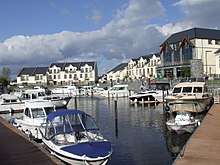Leitrim, County Leitrim
| Leitrim Liatroim | |
|---|---|
| Town | |
 Leitrim Location in Ireland | |
| Coordinates: 53°59′27″N 8°03′49″W / 53.9908°N 8.0636°WCoordinates: 53°59′27″N 8°03′49″W / 53.9908°N 8.0636°W | |
| Country | Ireland |
| Province | Connacht |
| County | County Leitrim |
| Elevation | 70 m (230 ft) |
| Population (2016)[1] | |
| • Total | 594 |
| Time zone | UTC+0 (WET) |
| • Summer (DST) | UTC-1 (IST (WEST)) |
| Irish Grid Reference | G958046 |
Leitrim (Irish: Liatroim) is a village in County Leitrim, Ireland.
Access and transport
It is located on the River Shannon at the junction of the R280 and R284 regional roads and is connected to the River Erne via the Shannon-Erne Waterway. Leitrim village is the gateway to the Shannon-Erne Waterway and boasts a quay, jetty and two marinas with excellent facilities for the cruising traffic which regularly passes through. The village is just over 5 km from Carrick-on-Shannon and 155 km from Dublin.
Modern development

2 May 2010
Successive Finance Acts during the 1990s encouraged the building of hotels and holiday houses in designated deprived rural areas. The village was a large beneficiary of these tax incentives. The resultant explosive growth in the period between 2002 and 2007 saw several large complexes of self-catering apartment blocks being erected around the marinas, one of which was funded by the International Fund for Ireland under the auspices of the Anglo-Irish Agreement. It is a well kept village with an excellent record in the Tidy Towns competition, and it once actually won the title. Leitrim village is well situated as a base from which to explore surrounding attractions such as the Arigna Mining Experience, Lough Rynn, Lough Key Forest Park, the Shannon-Erne Blueway and the nearby County Town of Carrick on Shannon.
For a relatively small village, Leitrim punches well above its weight in terms of facilities. There are five Bars, four restaurants, a 3star hotel and a first class takeaway. Its Mace convenience superstore also boasts a superb Deli Counter. Apart from supplying liquid and solid fuels, the garage runs an attended car wash and specialised valeting service. Tourism wise, the village offers a host of accommodation choices including the hotel, several upmarket Guesthouses, self catering options (including boat hire), and camping, glamping, campervan and caravan options in nearby Battlebridge. On the activities side, you can rent an electric bike or avail of indoor shooting gallery and archery facilities.
Education
- St Joseph's National School
Religion
- St Joseph's Catholic Church
Demographics
The village had 274 residents in 1834.[2] In 2016, the population was 594.[1]
History
From the Early modern period, County Leitrim is named after the village. Throughout at least the 19th and 20th centurys, numerous annual fairs were held at Leitrim village on- 22 January, 20 February, 25 March, 5 May, 16 June, 23 July, September 1 (or 3rd), 13 October, and 1 December.[2][3][4] In 1925, Leitrim village comprised 30 houses with 5 being licensed to sell alcohol.[5]
Liatroim was a strategically important ford of the River Shannon connecting Ulster and Connacht. The Irish Annals makes mention of Leitrim village (Irish: Liath-druim) many times. In 1270 the Battle of Áth an Chip between Normans and Connacht probably occurred on Drumhierney townland beside Battle-bridge.
The county itself is named after the village of Leitrim near the River Shannon, which was an important stronghold during the Ó Ruairc family reign. The name 'Leitrim' itself is derived from the Irish Liath Druim, meaning 'grey ridge', and is a common place name throughout Ireland.
See also
References and notes
Notes
Citations
- 1 2 "Census 2016 Sapmap Area: Settlements Leitrim". Central Statistics Office (Ireland). Retrieved 4 June 2018.
- 1 2 Wright 1834, pp. 24.
- ↑ Longman 1819, pp. 405.
- ↑ Watsons 1830.
- ↑ Irish Free State 1925, pp. 31.
Secondary sources
Historical
- Wright, G. N. (George Newenham) (1834). A new and comprehensive gazetteer (PDF). vol. IV. London, T. Kelly.
- Longman (2011) [1819]. Traveller's New Guide Through Ireland, Containing a New and Accurate Description of the Roads (digitized from original in Lyon Public Library ed.). Longman.
- O'Clery, Lughaidh. The life of Hugh Roe O'Donnell (PDF). Dublin: Fallon and Co, 16 Lower Sackville Street.
- Watsons (1830). The Gentleman's and citizen's almanack ... for the year (PDF). Dublin, Printed for S. Watson [etc.]
- Irish Free State (1925). Intoxicating Liquor Commission Report (Report). Reports of Committees. The Stationery Office. Retrieved 21 May 2017.
Irish annals
- Annals of the Four Masters, ed. & tr. John O'Donovan (1856). Annála Rioghachta Éireann. Annals of the Kingdom of Ireland by the Four Masters... with a Translation and Copious Notes. 7 vols (2nd ed.). Dublin: Royal Irish Academy. CELT editions. Full scans at Internet Archive: Vol. 1; Vol. 2; Vol. 3; Vol. 4; Vol. 5; Vol. 6; Indices.
- Bambury, Pádraig; Beechinor, Stephen (2000). "The Annals of Ulster" (Electronic edition compiled by the CELT Team (2000) ed.). CELT: Corpus of Electronic Texts: a project of University College Cork College Road, Cork, Ireland—http://www.ucc.ie/celt.
- Walsh, Paul (2012). "Beatha Aodha Ruaidh Uí Dhomhnaill". CELT: Corpus of Electronic Texts: a project of the Department of History, University College, Cork College Road, Cork, Ireland—http://www.ucc.ie/celt.
